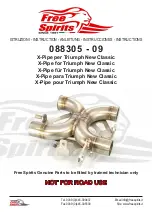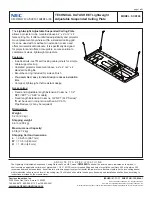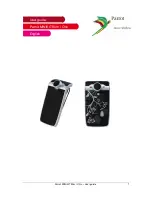
Drill Mounting Holes
To mount the wheel weights, two 7/16 inch holes need to be
drilled in each wheel. This drilling can be done without removing
the wheels from the tiller.
1. Carefully cut the template (see attached sheet) along the inside
and outside dotted lines.
2. Place the template in the center of the wheel well, making sure
that the arrow on the template is aligned with the air valve
stem, as shown in Figure 2. Secure the template to the wheel
with several strips of masking tape.
3. Using a center punch and hammer, punch two drill guide
marks exactly through the center of each (+) sign on the tem-
plate. Remove the template and punch these marks again for
easier drilling. The guide marks are 5 inches apart, which is the
correct center-to-center distance for mounting the wheel
weights.
4. Drill a 1/4 inch “pilot hole” through the wall of the wheel.
Repeat with the 7/16 inch drill bit, or use a 3/8 inch drill bit and
ream the edges of the hole to 7/16 inch. At all times, keep the
drill centered to ensure that the correct distance between the
mounting holes is maintained.
5. Repeat steps 2 through 4 for the second wheel.
Mount the Wheel Weights
1. Place a wheel weight inside the wheel well, making sure that
the notch in the back of the wheel weight (look for the words
“Valve Stem”) is aligned with the air valve stem.
2. Place a flat washer on the bolt and insert the bolt through the
wheel weight and the wheel. Add a lockwasher and nut as
shown in Figure 3.
3. Use two 9/16 inch wrenches to tighten each bolt and nut. Do
not over tighten, as damage to the wheel weight shell could
occur. Compressing the lockwasher is sufficient.
Wheel Weight Notes:
• If you use the tiller for cultivating, allow an extra 3 inches of
width on either side of the tires when you plant your rows.
• When making turns on lawns, use caution to avoid the heavy
wheels digging up the turf. Follow turning instructions in your
Owner’s manual and try lightly “hopping” the inside wheel
while turning.
• If you have a 1978 or newer 6 HP Model, you may notice a de-
crease in engine RPM when tilling deeply with wheel weights.
This is normal and is caused by the improved traction of the
tiller, allowing the tines to dig deeper. To take full advantage of
this feature, move the drive belt to its low speed range.
CAUTION
Read instructions provided with the power drill
before using. Follow all safety instructions.
CAUTION
Do not drill outside the flat area in the center of the
wheel well. Doing so will puncture the air-tight seal
between the tire and the wheel rim and cause the
tire to go flat.
VALVE
↓
Fig. 2
For customer assistance, contact your nearest authorized dealer or:
TROY-BILT LLC, P.O. BOX 361131, CLEVELAND, OHIO 44136-0019, 1-866-840-6483
Printed in U.S.A.
Form 769-00028 (11/01)
Fig. 3
1
2
3
4
5




















